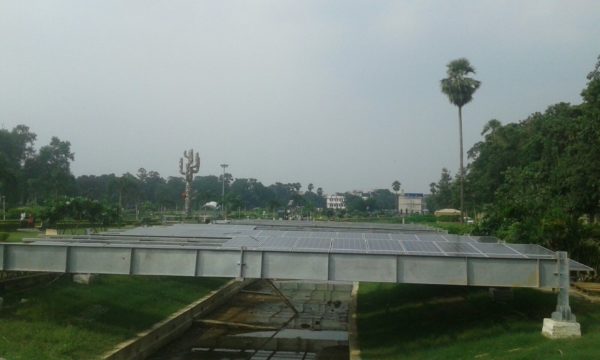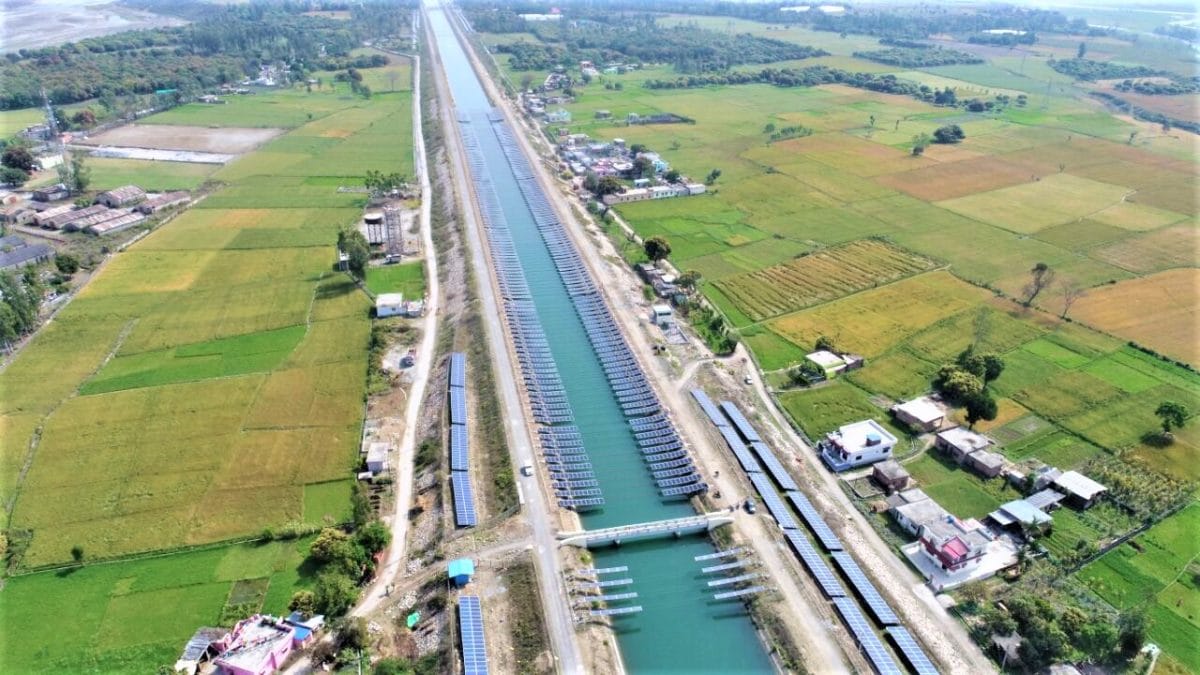Canal-top solar is an innovative approach adopted by India to provide a renewable energy source for farming activities without consuming agricultural land. Such projects benefit from easy grid availability as most of India’s large canal systems have mini hydel plants on the canal with grid access in place.
The solar power generation potential from canal-top solar plants is significant at a minimum of 10 GW, considering installation atop major canal systems in India, not their minor canals.
Module manufacturer and EPC installer Premier Energies executive director Sudhir Moola told pv magazine: “India has around ten major canal systems covering a length of about 10,097 km. Even if 50% of this canal length (about 5000 km) is usable for canal-top solar installation, we can do 2-3 MW for every km of the canal, assuming 15-20metre canal width. That gives us a potential 10 GW of canal-top solar power systems that can be installed saving more than 40,000 acres of land.”
Apart from this, covering the canal with PV panels also leads to canal water savings as shading provides a cooling effect and reduces the water loss due to evaporation, he added.
Capacity installed
The State government of Gujarat mooted the idea of canal-top solar in India in 2011 as it looked for ways to increase renewable energy production without land conflicts. This led to the commissioning of India’s first canal-top solar project at Chandrasan village, about 45 km from Ahmedabad. The 1 MW PV plant was set up on a 750 m stretch of Sanand branch canal.
The project was developed by Gujarat State Electricity Corporation Limited with support from the Sardar Sarovar Narmada Nigam Limited, which today has 35 MW of such projects (20 MW canal-top and 15 MW canal-bank) commissioned with tender out for a further 100 MW canal-top solar.
Encouraged by the project’s success, in the year 2014 the Ministry of New and Renewable Energy (MNRE) launched a pilot–cum–demonstration project scheme to develop an aggregate 100 MW of grid-connected solar PV power plants on canal banks and canal tops through state-run agencies.
The scheme provided viability gap funding (VGF) support of up to INR 3 crore/MW for canal-top PV projects and INR 1.5 crore/MW for canal-bank installations. The VGF was to fund the additional cost due to canal-top structure.
Under this Scheme, based on the allocation requests received from different States, the MNRE sanctioned full targeted capacity of 50 MW canal-bank and 50 MW canal-top solar PV power projects in the States of Andhra Pradesh, Gujarat, Karnataka, Kerala, Punjab, Uttarakhand, Uttar Pradesh and West Bengal. As of March 31, 2019, 50 MW canal-bank solar PV projects and 44 MW canal-top solar PV projects were commissioned.
The scheme is now closed for new sanctions.
Installation
Pulkit Dhingra, founder and director, AHA! Solar (a digital solutions provider for project management), said: “Canal-top solar installation requires a shadow-free stretch of canal with an ideal width between 20 and 30 metres. A motorable road along the canal allows for development and maintenance. North-south canal flow is ideal [to get maximum output from the panels], but east-west direction can also be used for panel installation.”
Canal-top projects cost more than normal ground-mount and floating solar PV plants as these require a significant structure to span the canal to support the panels. While land-based installations cost around INR 3 crore/MW, the cost for canal-top installation could be INR 4.5-6 crore/MW depending upon the canal width, according to Premier Energies’ Sudhir Moola.
The main component that makes the difference is the support structure. The structures could be installed end-to-end or without touching on the ends of the canals. In the latter approach, piers are installed within the canals and panels mounted such that these don’t touch the end of the canals so that the canal ends are not disturbed. For wider canals, such as those in Punjab, it’s important to install piers within the canals.

Image: Premier Energies
Another approach is to use suspension with high tensile steel to mount the modules. Premier Energies is the only company in India to implement this approach for the 1MW canal top system in 2017 in Uttarakhand. Till date, this is the widest canal-top installation in India with a width of 35 metres and no piling done inside the canal.
“I don’t think you will find this anywhere in the world. And the plant has been performing for last four years with no incidents despite being subject to high winds being close to Yamuna river,” stated Sudhir Moola.
The innovation in design can be a great boon for canal-top solar projects across the world, according to Pulkit Dhingra. “Innovative designs like cantilever type [a beam anchored at only one end to a vertical support] can help to decrease the cost and still utilize the canals for generating solar power,” he added.
The other designs can be putting support during the construction phase of the canal itself. “If the canal-top is planned at the time of construction of canals, it can help reduce in capital cost and solve both the purpose of generation of electricity and saving water,” Pulkit said.
Modules
Canal-top installations in India use polysilicon module technology due to its better cost economics. “The cost of structures for canal top in itself is high, so using a commercially viable technology makes better sense. Moreover, in the conditions like India, polysilicon provides better performance,” Pulkit said.
Speaking about using bifacial panels, he said these can be a better option considering they reduce the structure’s overall weight, and structure cost in the canal-top solar is a significant cost.
However, the commercial viability of bifacial modules needs to be checked. “If the reduction in the structure’s weight is less and increase in the cost is high, then it doesn’t make sense, he added.
Challenges
Too wide or too narrow canals pose a challenge to designing an efficient and cost-effective system. The support structure goes up by quite high as the span of the canal increases.
“In a normal land-based project, you can install columns at three to four meters length, which is the span of the structure. Whereas in a canal, you can have one column post at the descent to support the structure, and on the other side, you can have one more. So when the span increases, the type of structure the column weighs go up quite high,” explained Sudhir.
The canal width should be ideally 20 to 22 meters to keep the structure’s cost under control, said Pulkit Dhingra, adding that the canal’s depth doesn’t matter much.
Apart from canal width, canal orientation and running water also pose challenges. The canal orientation would be a challenge in designing the panel orientation while trying to maximize generation. That apart, installation of solar PV panels and system with running water in the canal poses higher safety issues than ground-mount or floating solar power plants.
Further, the support structure must allow access to the canal and not impact the canal and canal lining. Module cleaning and operation and maintenance could also be a challenge considering access to panels.
In its installations, Sudhir Moola said, Premier Energies maintains a structure-to-structure gap of four to five meters. So, there is a gap for people to lay their pipelines to take water from the canal.
A floating pontoon could be used for periodic desilting/cleaning of the canal’s bed to maintain the safety of the canals and smooth flow of water.
This content is protected by copyright and may not be reused. If you want to cooperate with us and would like to reuse some of our content, please contact: editors@pv-magazine.com.









2 comments
By submitting this form you agree to pv magazine using your data for the purposes of publishing your comment.
Your personal data will only be disclosed or otherwise transmitted to third parties for the purposes of spam filtering or if this is necessary for technical maintenance of the website. Any other transfer to third parties will not take place unless this is justified on the basis of applicable data protection regulations or if pv magazine is legally obliged to do so.
You may revoke this consent at any time with effect for the future, in which case your personal data will be deleted immediately. Otherwise, your data will be deleted if pv magazine has processed your request or the purpose of data storage is fulfilled.
Further information on data privacy can be found in our Data Protection Policy.